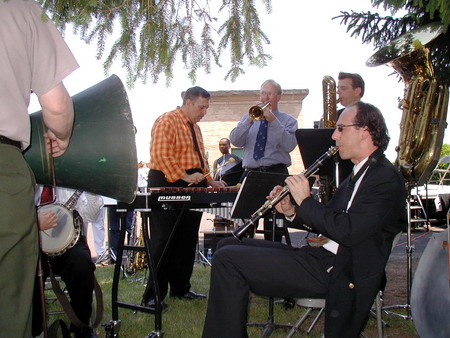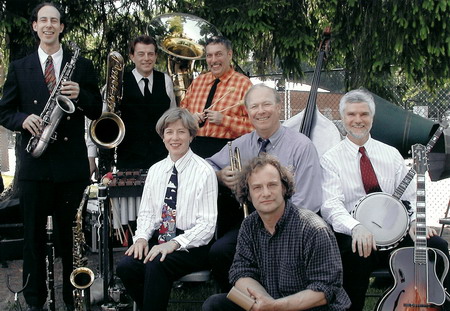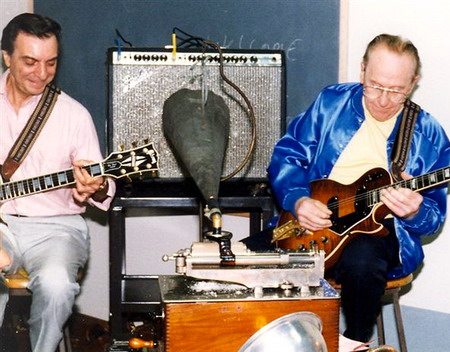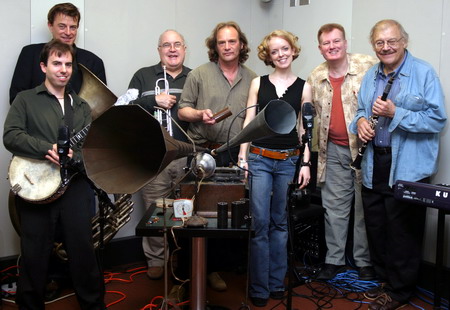|
The Wizard Cylinder Record Company
by Peter N. Dilg
The Wizard Cylinder Record label started in October 2002. The Wizard trademark, with black cat and phonograph, was copyrighted on September 14, 2004.
I felt there was a demand for these records because of the scarcity of original 2-minute wax cylinders (due to their fragility and susceptibility to
mold damage). I also wanted to offer a selection of durable 2-minute cylinders that would offer a mixture of music genres ranging from talking records,
to fox trots, ragtime and early jazz, which are always sought after by collectors. Our catalogue provides the variety and flexibility of offering
reissues of original cylinders as well as the production of new acoustic recordings. The hard and smooth composition of the present Wizard Cylinder
Record now before the public has enabled us to do exactly these things. The perfected Wizard Cylinder Records are made of a very stable and durable
phenolic resin, using a mixture of old and new technologies.
Origins
I started collecting old phonograph recording equipment back in the 1960s by going junking, looking into local antique shops and receiving apparatus
from old timers who were in the field. I bought stuff from Thomas Edison's last official dealer, Clarence Ferguson, who lived in Wisconsin. I remember
that he didn't even charge me for half of the items. I was surprised when he told me that there was never much call for home recording equipment. A
lot of my research goes back to the late 1970s, just before the introduction of the old Electrophone Cylinders in the early 1980s produced by myself
along with Dennis Valente (of Floral Park, NY) in association with Miller-Morris (of England). These were the first new entertainment cylinder phonograph
records manufactured in the United States since 1929. We started off using Miller-Morris-prepared brown wax cylinder blanks and then, after obtaining
the rights to their wax formula, we began casting and shaving our own Electrophone brown and black wax blanks in the USA, also adding an engraved rim.
At the very beginning, cylinders were recorded at 945 Church Street, Baldwin, NY and the blanks were prepared at Dennis Valente's shop on 32 South Tyson
Avenue, Floral Park, NY (owners of Antique Phonograph Supply Co). Later on, recording was moved to our studio at 906 Merrick Road, Baldwin, New York,
the home of the present Wizard Cylinder Records.
I hand-built the electrical cutters at the time - a lot of tinkering was done back then to determine what worked best. Even Theodore Edison gave me
some tips on his electrical cutters. A special master phonograph was designed. The next generation of cylinders was made utilizing a master mould. A
lot of experimentation with measurements and groove pitch on the mastering end of the process had to be tried to determine the proper shrinkage rate
of the moulded bright red vinyl cylinders. A mould with a seam of course should not be used (it would make clicking noises with each revolution during
playback). The wax master itself, having a groove pitch of 98 threads per inch, is used to create the metallic cup-like mould for making the standard
100 threads per inch copies that are played on your phonograph. Because one can't use a two-sided mould to cast cylinders, since the resulting flange
would be impossible to remove, the casting material has to have a special quality, a 2% shrinkage rate on solidifying or cooling. This shrinkage is
essential to allow the finished resin casting to be released from the cup-like metallic mould. Don't forget that much of this mould process had to
be 'rediscovered' because of the secrecy involved in the commercial production by the cylinder industry years ago. It was hard to find technical
processes in print. In the old days, as today, trade secrets were kept confidential within the company because of the fear of piracy. Due to the
problems with shrinkage of the vinyl, we moved on to the third generation, black polypropylene which proved to be a lot more stable. One special
release was of a clear picture record, No. 8001 of Thomas Edison telling his Liver Story joke. There was also a limited issue of an orange-colored
polypropylene cylinder, No. 8002 of Thomas A. Edison playing the piano! Polypropylene is good for 2-minute records but is not hard enough to withstand
a diamond without a chance of damage. A lot of knowledge was gathered from this 'hands-on' research. At the time, we sold quite a few records as well
as the recording blanks for the hobbyist. Some of these Vintage Electrophone Cylinder Records are collectors' items now and there is lots of interesting music on them.
Recording

|
|
Outdoor recording of Greens New Novelty Orchestra
|
|
|
Today, Wizard cylinder records are produced in a manner similar to the way it was done 100 years ago. An oversize wax master record is made on a
master recording phonograph and is kept slightly warmed prior to and during the recording session, in order to make a deeper and cleaner cut. When
cutting properly, the wax shavings or 'swarf' should come off the surface in fine curls. Many sound-level tests are made and I try to get three good
takes of each selection in case of technical problems, which often occur. After the oversized perfect recorded wax master cylinder is selected, the
matrix numbers are inscribed by hand on the wax master's playing surface. It is then expertly dusted with graphite and electroplated to make a metallic
"permanent" mould.
Utilizing Wizard's Special 'Miller Process', the records are moulded into a fine, velvety smooth resin copy. An engraving is made for the title end
of the cylinders and then the letters are filled with white pigment, just like old original cylinders. The smooth yet hard surface of these records
is similar in appearance and durability to the thermoplastics developed by Thomas A. Edison and Jonas Aylsworth used for the playing surface lamination
on Diamond Disc Records. This is the direction Edison was going in an attempt to improve the wearing qualities of his wax 4-minute Amberol cylinder
records. By 1912, however, he had obtained the rights for the use of celluloid which was used in the Blue Amberols, which I'm sure, was cheaper and
faster to produce. Wizard Records are similar to Diamond Discs in terms of extreme durability and quality but are obviously in a cylindrical form.
Each record is handmade, inspected and tested for uniformity. Making a good cylinder record is not an easy task; so many things can go wrong.
After all this I take my hat off in appreciation to Thomas A. Edison and his Staff for perfecting the Blue Amberol and Diamond Disc Records
which are truly works of Art.
We have been sometimes asked how many copies can be made from one given mould. We do not know for certain the number of cylinders that can be formed
because so far damage has been caused by accidental scratching, not by actual wear of the mould. Right now we are using the mother mould to press with,
so it is safe to assert that they are truly limited editions. Our moulding process may change and improve in the future, especially if demand increases.
I must mention that, inevitably, just like in the old days, the moulds do get damaged from time to time during production and those titles must be withdrawn
from the listing, and there is a chance they will never re-appear. Therefore, all the catalogue titles are limited editions. Some past titles are still
in demand but unfortunately have already been discontinued. So it is always advisable to order shortly after new records are first released.
Available Formats
Right now there are three types of cylinders available: 2-minute, standard size, 100 grooves per inch, 160 rpm (2Ό inch diameter) selling at $25.00
each, and the 4-minute, standard size, 200 grooves per inch, 160 rpm (2Ό inch diameter) selling for $35.00, and the 5-inch diameter Concert Grand size,
100 grooves per inch, selling at $200.00. All three types are of the same hard resin composition. Due to the superior Concert Grand's high surface
speed of recording, the cylinders play exceptionally loud and clear with a brilliant tone.

|
|
Group shot of Peter with Greens New Novelty Orchestra
|
|
|
At the time of this article, a couple of 4-minute titles have been manufactured. They are a little higher in price than the standard 2-minute
cylinders because of the extra delicate work required in the making of the master for the 200-thread groove. The emphasis has been on the standard
100-groove, 2-minute cylinders due to the scarcity of their titles. Regardless of whether you have a standard size 2-minute or 4-minute machine,
or a 5" Concert Grand, all Wizard Cylinders are great for demonstration purposes because of their durability.
You can play these records on any cylinder phonograph or Graphophone with the appropriate gearing and stylus for either 2- minute or 4-minute
cylinders. Actually, I found that a 4-minute diamond stylus, like in the Edison Diamond B Reproducer, even plays the 2-minute type Wizards beautifully,
with no signs of cylinder wear. They seem to be unaffected by normal conditions, hot, cold, humid or dry. So far, I have not had any cylinders break,
crack or wear out. Of course, a bad stylus or any hard abuse would hurt any record surface and dust should not be allowed to gather on any record's surface.
I have found these cylinders to be great items to include in a Talking Machine Sale to get customers familiar with the handling of their new machines
and records before they try handling original wax cylinders. After handling all kinds of cylinder reproducers, I have noticed that half of them have the
styli worn or even chipped (especially the 4-minute type, including hard diamonds) to the point where they give poor audio reproduction and are
possibly permanently destroying the sound grooves. It is always best to make sure that your reproducing stylus is in tip-top condition. All cylinder
records deserve a perfect reproducing stylus. Also, check your reproducer and make sure that its rubber gaskets are soft and pliable. This factor is
very important to get the most sound out of your records and to eliminate possible wear on perfectly good records.
Record Titles are in three categories at present:
For the 2-minute cylinders there are:
|
|
The 100 series reissues of fine examples of original cylinders.
|
|
|
The 6000 and 06000 series both consist of newly produced recordings, but the 6000 series so far are recordings using the authentic Edison acoustic studio-recording.equipment that I own.
|
For the 4-minute cylinders there are:
|
|
The 1000 series reissues of fine examples of original cylinders.
|
|
|
The 4000 series so far reserved for future newly recorded records.
|
For the 5" Concert Grand Cylinders there is:
|
|
The C series reissues of fine examples of original cylinders.
|
Modern-day Recordings

|
|
Les Paul recording session
|
|
|
Over the years, I have been incredibly fortunate to know some very talented musicians and singers, real professionals who have an appreciation for
old-time music recorded in the old, direct acoustic way. Some of these entertainers have recorded on most every other format, CDs, tape, and LPs,
and have even appeared on TV and in movies. Now that they have recorded acoustic records, that is to say direct mechanically recorded wax cylinders
by performing into a horn using only the phonograph's recording diaphragm to vertically vibrate and cut a wax cylinder, they have entered the acoustic
time tunnel. They hear themselves as they would have sounded had they made the recording 100 or so years ago. Most artists, after hearing themselves
upon playback, come to the realization that the machine captures the real soul of their performance.
While doing a session with us at the Edison Laboratory, Les Paul, the pioneer of the electronic guitar, picked out the recording horn that he liked
best and was surprised at how well the phonograph reproduced his electric guitar. As you know, he is also a recording engineer. The cylinders we
recorded that day sounded brilliant. During another session, also at the Edison Laboratory, Mary Travers of Peter Paul and Mary remarked to me
while listening to a test play-back, "Wow, that really sounds like us singing out of that horn." Peter and Paul were also surprised and were of the same opinion.
Even with the phonograph's limited frequency response, the recording still has natural and pure characteristics about it. After listening to some
test playbacks with his septet, Wynton Marsalis, the great trumpet player, liked the way he sounded because the band had a natural, early acoustic
King Oliver-Louis Armstrong sound. He even went so far as to ask his Sony recording engineer why he couldn't get his band to sound the same way.
The engineer later asked me how he could possibly get that same sound electronically and I simply put it, "You can't because this system works
entirely on vibrating air pressure to modulate the cutting stylus." There is no electronic distortion.
New Titles Available
(Editor's note: see list below of other titles available)
Some of the Wizard Artists and the titles we have recorded for the 6000 series are as follows:
Dan Levinson's Roof Garden Jass Band
|
|
No. 6001 Livery Stable Blues
|
|
|
No. 6002 Dixie Jass Band One Step
|
|
|
No. 6008 Blues My Naughty Sweetie Gives To Me
|
|
|
No. 6012 Swanee One Step
|
These selections were recorded in a barn loft on Shelter Island, N.Y. Recordings were being made from late evening into the wee hours of the morning.
These are authentic jazz recordings in the original Dixieland jass band tradition. Artistically, I feel that these records are as good as the
original Dixieland Jass Band renderings from 1917. Dan Levinson travels all over the world specializing in this type of music. Joe Lauro was the
guest announcer on these first recorded Wizard issues in this series. For more information on Dan go to http://www.danlevinson.com.
David Sager's Fearless Orchestra featuring Ferebee Thulman and Douglas Bowles- vocals
|
|
No. 6003 Who Dat Say Chicken In Dis Crowd? instrumental cakewalk
|
|
|
No. 6004 Some of These Days featuring Ferebee Thulman - vocal
|
|
|
No. 6007 Honey Boy featuring Douglas Bowles vocal with whistling
|
These selections were recorded in front of a live audience at the Edison Laboratory, West Orange, New Jersey in building No. 6 as a demonstration
of the recording process on their annual 'Edison Day' celebration. Dave Sager is an authority on this kind of music, and did a wonderful job on these
cylinders. He also plays a mean trombone. A real Stroh Violin was used for this session as well. The professional guest announcer was Anthony Wellman.
For more information on David Sager go to http://www.davidsager.com.
Green's New Novelty Orchestra
|
|
No. 6009 Triplets featuring Ian Finkel on xylophone
|
|
|
No. 6010 Sweet Georgia Brown
|
These were outdoor acoustic field recordings held on the grounds of the Edison Site for a live audience right over the spot where the old
Edison Works used to be. This day was extremely hot - it got close to 100 F! Lew Green's father and his two uncles (Lew, George and Joe) were the
famous Green Brothers Novelty Orchestra that made cylinders and Diamond Discs for Edison and 78rpm Gramophone Companies that were so popular during
the late teens into the late 1920s. I have noticed if I demonstrate a phonograph with a Green Brothers record there is a better chance of a sale
because of its syncopation. Lew's Uncle, George Hamilton Green, wrote "Triplets" and Ian Finkel does a wonderful job on the xylophone in a traditional
manner on this Wizard Record No. 6009. Every artist in this particular group is a well-known musician in his own right. Vince Giordano sat in this day
and can be heard on "Sweet Georgia Brown" playing the bass saxophone solo near the end of the tune. To learn more about Lew Green and his wife Mary,
visit their website http://www.greensmusic.com.
Rick Benjamin's Paragon Ragtime Orchestra:
|
|
No. 6013 Maple Leaf Rag
|
|
|
No. 6014 Alabama Jubilee
|
|
|
No. 6022 Contentment Rag
|
These three titles were acoustically recorded live at the WFMU Radio Studio for Jerry Fabris' radio broadcast entitled 'Thomas Edison's Attic',
where he plays lots of original and rare recordings out of Thomas A. Edison's vault. Jerry is the sound curator, etc., at the Edison Laboratory
at West Orange, New Jersey. We have done lots of recording sessions together using original Edison recording equipment. You can still listen to
the entire original broadcast by visiting the WFMU Website at http://wfmu.org/playlists/te and clicking
on the June 14th 2005 broadcast.
(Editor's note: Some of the recordings made at the radio studio are presented electronically and acoustically. You can make an interesting
comparison between the two recording methods for yourself).
This program was a lot of fun to do and some authentic ragtime selections were recorded. It was a bit cramped, with a full orchestra just like the
old days, in a small studio and extremely hot (which was good for the wax), but everyone was a good sport. Ragtime is in Mr. Benjamin's blood and
along with his talented orchestra (which includes his lovely wife Leslie who plays flute and piccolo, etc.) he brings us back to the ragtime days
with these recordings. Two horns were used together with a real 1898 Studio Edison Recording Machine. For more information on Rick Benjamin and his
Paragon Ragtime Orchestra go to http://www.paragonragtime.com.
Richard Halpern with Vince Giordano and Earl Norman on piano
|
|
No. 6016 Me and My Shadow
|
|
|
No. 6011 I've Got a Feeling I'm Falling
|

|
|
Group shot during the Nancy Anderson recording session
|
|
|
These selections were recorded at Vince Giordano's home in Brooklyn using two horns - one for the piano and one for Richard to sing into.
Richard Halpern is a multi-talented entertainer. He is billed as 'Mr. Tin Pan Alley' and he is also the official impersonator for the Michael
Meier's character Austin Powers and has done a newly released CD of the voice of Popeye the Sailor Man. You can learn more about Richard Halpern
by visiting is website http://www.richardhalpern.info. Vince Giordano (of Vince Giordano and His Night
Hawks Orchestra), is a personal friend of mine and has helped me with my recording exploits dating back to the mid-1970s. You might remember him on
the Electrophone Two-Minute Cylinders (now out of print) No. 5001 entitled "Crazy Rhythm" and No. 5010 "The Moon and You" (his signature tune and
used in Hal Roach comedies). Vince continues to entertain people and can still be heard in films, on radio, in night clubs, and he has recorded
numerous CDs. Years ago, around 1978, I even recorded a Concert Record of his band, The Night Hawks, doing "Thinking of You".
I just received test pressings of a session that I did with Nancy Anderson and the jazz musical accompanist 'The Bronx Bombers' doing the
title "True Blue Lou". The record number is 6020. You can hear the recording at Nancy's website http://www.nancyanderson.name.
Click on the recording link and see a photo of the session as well. Also recorded that day was an instrumental piece by 'The Bronx Bombers', a
Lew Pollack and Ray Gilbert 1914 hit, "That's a-Plenty" on Wizard record No. 6023, which is a snappy one-step. The guest announcer on these
two records is radio personality Rich Conaty who hosts WFUV's weekly radio program "The Big Broadcast".
I also want to pay particular attention to a future release of the famous standard "The Man on The Flying Trapeze". This was an experimental
recording made with an antique calliope owned and played by my old friend Jim Koehler. The wax master came out so well that we decided to issue it.
It will be record No. 6021. It gives your cylinder phonograph the effect of an antique circus calliope, to the tune of "He flys through the air
with the greatest of ease, that daring young man on the flying trapeze". Mr. Koehler is a true virtuoso and plays this tune traditionally. I'm sure it
will be a hit with the public. Mr. Koehler has in his possession a wax cylinder that he and I recorded back in the late 1960s.
In conclusion, we feel we have an unique product at a reasonable price that can add new life to your old phonograph.
The author would like to acknowledge and thank his wife Virginia, for all her assistance and support in preparing this article.
WIZARD TWO MINUTE INDESTRUCTIBLE CYLINDER PHONOGRAPH RECORDS
STANDARD SIZE
| No.
|
Title
|
| 107
|
A Christmas Ghost Story Talking Harry Grafton
|
| 108
|
Black and White Rag Played by The American Symphony Orchestra
|
| 110
|
The Star Spangled Banner Played by The Edison Military Band
|
| 111
|
My Old Kentucky Home Sung by The Edison Quartet
|
| 6001
|
Livery Stable Blues Played by Dan Levinson's Roof Garden Jass Band
|
| 6002
|
Dixie Jass Band One Step Played by Dan Levinson's Roof Garden Jass Band
|
| 6003
|
Who 'Dat Say Chicken in 'Dis Crowd? Ragtime Played by The Fearless Orch., David Sager-Director
|
| 6004
|
Some Of These Days Soprano Solo Sung by Ferebee Thulman with The Fearless Orchestra
|
| 6007
|
Honey Boy Tenor Solo Sung by Douglas Bowles with Fealess Orchestra-David Sager-Director
|
| 6008
|
Blues My Naughty Sweetie Gives To Me Played by Dan Levinson's Roof Garden Jass Band
|
| 6009
|
Triplets Played by Green's New Novelty Orchestra featuring Ian Finkel on the Xylophone
|
| 6010
|
Sweet George Brown Fox Trot Played by Green's New Novelty Orchestra
|
| 6011
|
I've Got A Feeling I'm Falling Sung by Richard Halpern
|
| 6012
|
Swanee One Step Played by Dan Levinson's Roof Garden Jass Band
|
| 6013
|
Maple Leaf Rag Played by Rick Benjamin's Paragon Ragtime Orchestra
|
| 6014
|
Alabama Jubilee Played by Rick Benjamin's Paragon Ragtime Orchestra
|
| 6016
|
Me and My Shadow Sung by Richard Halpern
|
| 6018
|
East Virginia Blues Sung by Sean Condron
|
| 6019
|
Roll Down The Line Sung by Sean Condron
|
| 06115
|
Five Foot Two, Eyes Of Blue Fox Trot Webb's New Society Syncopators
|
| 06308
|
Friendless Blues Rag (Slow) Fox Trot Played by Webb's New Orleans Five Jazz Band
|
WIZARD INDESTRUCTIBLE CONCERT GRAND CYLINDERS
5" IN DIAMETER
| No.
|
Title
|
| C1
|
The Friendly Rivals Cornet Duet, Played by John Hazel and Herbert L. Clarke
|
| C2
|
The Star Spangled Banner Played by The Edison Military Band
|
| C4
|
Liberty Bell March Played by the Edison Military Band
|
Standards - $25.00 each
Concerts - $200.00 each
Shipping and Handling Not Included
(New York Residents must add 8.625% Sales Tax)
Due to availability, please make a second choice.
If you have any questions or would like to be put on the Wizard Mailing List or would like to order cylinders,
contact:
Peter N. Dilg
Baldwin Antique Center
906 Merrick Road
Baldwin, New York 11510 USA
Telephone: 516-223-0533 (please leave a message)
E-mail: Verticalcut@earthlink.net
|